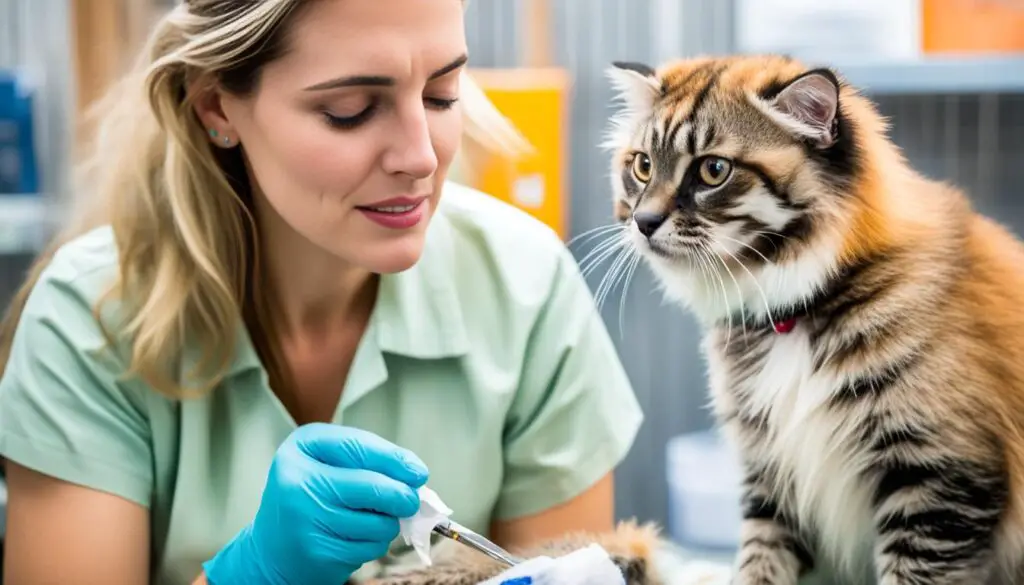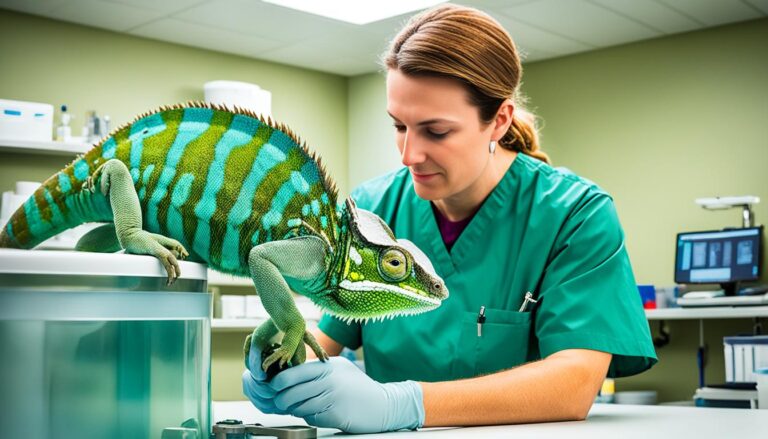Exotic Pet Training & Behavior Aids Tips
Did you know exotic pets need special attention, especially in training and behavior? They are not like our usual pets. They have different ways and needs that are unique to them.
This guide will show you how to train and handle the behavior of exotic pets. Whether you own a reptile, bird, small mammal, or any unique pet, these tips will make things easier. You’ll learn how to understand your pet’s behavior, meet their needs, and make a safe space for their training.
Key Takeaways:
- Exotic pets require specialized training and behavior management techniques due to their unique needs.
- Understanding their behavior and species-specific needs is crucial for effective training.
- Creating a safe and secure training environment is important to avoid injuries and ensure successful learning.
- Training aids and supplies designed specifically for exotic pets can enhance the training process.
- Regular observation and recognition of normal behavior in exotic pets is essential for identifying health issues.
The Importance of First Aid for Exotic Pets
Exotic pets need special health care. Owners must know first aid and how to help in emergencies. Fast care is key to their health.
These pets can face accidents or sudden sickness. With first aid, you can help them until the vet arrives. This can keep them stable.
Having the right first aid tools is crucial. A proper first aid kit has bandages, disinfectant, and vet-approved medicine. Remember, it’s a first step, not the final care for your pet.
Learning about your pet’s health is vital. Know what to watch for and when to act fast. Always be sure you can help safely before starting first aid.
Key Steps in Providing First Aid for Exotic Pets:
- Assess the situation and ensure the safety of both yourself and the animal.
- Stabilize the exotic pet if necessary, taking care not to further injure or stress them.
- Contact a veterinarian immediately to seek professional advice and instructions.
- Follow any specific first aid procedures provided by the veterinarian over the phone.
- Administer basic first aid measures as instructed, keeping the animal as calm and comfortable as possible.
- Transport the exotic pet to the veterinary clinic as directed, taking extra precautions to ensure their safety during transportation.
In a medical emergency, acting quickly is vital. Knowing first aid can save your pet’s life. Be calm, prepared, and get expert help fast.
The Challenges of Training Exotic Pets
Training exotic pets is rewarding yet complex. These animals have unique behaviors and needs. They need a different training style than typical pets do. It’s important to know how they act, their health needs, and provide a safe training space.
Understanding Exotic Pet Behavior
Exotic pets act in various ways due to their instincts and habitats. It’s crucial to learn about each type’s behavior. This helps to train them effectively by using their nature as a guide.
Species-Specific Training
Each exotic animal species requires its way of training. Unlike cats and dogs, which we’re used to, they each have unique abilities and ways of learning. Adapt the training method to fit the animal’s needs. This makes sure the training is beneficial and caring.
“Training an exotic pet requires understanding and meeting their specific needs. It’s about offering an environment where they can learn and grow safely, at their own rhythm.”
A Safe Training Environment
It’s vital to create a secure place for both the trainer and the pet. Exotic pets can react strongly to their environment. They should have a space that meets their needs safely. This includes a setup that keeps them safe and focused during training.

| Challenges of Training Exotic Pets | Solutions |
|---|---|
| Limited Training Resources | Find experts, join groups, and do your research. This will offer you new insights and advice. |
| Unique Behavioral Patterns | Learn about each species’ natural behaviors. Use this to craft training methods that fit these instincts. |
| Communication Barriers | To get past language barriers, use positive methods such as clicker training. Visual signs can also help a lot. |
| Safety Concerns | Make the training environment safe. Cut down on things that could worry the pet. Also, have a plan for emergencies. |
| Patience and Persistence | Training exotic pets takes time. You need to be patient, keep at it, and always be dedicated to see results. |
Training exotic pets is a journey that needs you to be knowledgeable and flexible. Loving these unique creatures is essential. By knowing their behavior, catering to their needs, and offering a secure learning setting, you can make a strong connection with your exotic pet.
Recognizing Normal Behavior in Exotic Pets
Before checking for health problems, knowing what’s normal for your exotic pet is key. This helps spot health issues early, which is vital for their well-being.
Every exotic pet acts uniquely. Learning your pet’s behaviors lets you notice if something seems off. This is how you keep them healthy and happy.
Here are signs of a healthy exotic pet:
- Normal eating and drinking: An exotic pet should eat and drink enough for its type.
- Playfulness and curiosity: They must be interested in their world and play appropriately.
- Normal breathing and activity level: Watch for major changes in how much they move and breathe. This could show a health problem.
- Healthy coat and skin: Their skin and fur should look smooth, not flaky or miscolored.
- Regular elimination: They should go to the bathroom at average times. Odd changes might mean an issue.
Note that pets differ in behavior by age, personality, and more. Keeping a behavior log helps notice and deal with changes.
“Knowing what’s normal for your exotic pet is crucial for their health. Keep an eye on their actions and any changes that concern you.”
Evaluation Tips:
Here’s how to understand your exotic pet’s behavior:
- Watch your pet at different times daily to see their usual routines.
- Consider what’s typical for their species when looking at their behavior.
- Read up on your pet’s behavior from trusted sources for better understanding.
- Notice and act on any behavior changes, seeking help if needed.
Knowing and watching your exotic pet’s behavior is essential. Care for them well, stay alert, and call a vet if you’re worried. With good care, your exotic friend can have a great life.
Preventing and Addressing Stress in Exotic Pets
Exotic pets need special care to keep them healthy and happy. Managing and reducing stress is very important for them. Chronic stress can harm their health and change how they behave.
Exotic pet owners should look out for signs of stress in their animals. The signs differ from one type of animal to another. But signs like not eating well, excessive fear, and self-harm are usually signs of stress.
If you can spot these signs early, you can make changes to help your pet. Making their environment better can lessen their stress. This includes changing their food, playtime, or living area.
When handling exotic pets’ stress, you need to look at many factors. Their home and mental health are both important. Here are tips to make your pet’s life better:
1. Provide a Suitable Environment
Your exotic pet needs a place that feels safe and exciting. Learn about their species to set up the right home. Use the right light, temperature, bedding, and hiding places.
2. Establish a Consistent Routine
Exotic pets feel best when their days are predictable. Keeping a regular schedule for eating and playing is a good idea. It makes them feel secure.
3. Offer Enrichment Activities
Giving your pet tasks and toys can stop them from getting bored. Hide food for them to find or play together. These activities are fun and lower stress.
4. Ensure Proper Nutrition
A good diet is key to your pet’s well-being. Your vet can help you choose the best food. This is based on what your pet’s species needs to eat.
5. Minimize Exposure to Potential Stressors
Try to find and stop things that stress your pet. This might be loud noises, sudden changes in temperature, or other animals. A quiet and calm space is good for them.
By following these tips and keeping a close eye on your pet, you can help them stay happy and healthy. If you’re ever unsure, talking to a vet who knows about exotic pets is always a good idea.

| Signs of Stress: | Causes of Stress: | Ways to Reduce Stress: |
|---|---|---|
| Loss of appetite | Improper habitat conditions | Provide suitable environment Ensure proper nutrition Minimize exposure to stressors |
| Aggression or fearfulness | Excessive handling or social interaction | Establish a consistent routine Offer enrichment activities |
| Excessive grooming or self-mutilation | Boredom or lack of mental stimulation | Engage in enrichment activities |
| Isolation or withdrawal | Lack of social interaction | Provide socialization opportunities |
| Changes in body language | Environmental changes or stressors | Minimize exposure to stressors |
Creating a Safe Training Environment for Exotic Pets
Training exotic pets safely starts with the right environment. You need the right spaces and enclosures to keep them safe and help them learn.
Your exotic pet’s home must be safe. It should be big, escape-proof, and made of safe materials. The training area also needs to be perfect, so your pet feels at ease while learning new things.
“A secure training environment is key for learning. It keeps both you and your pet safe, making training less stressful and more effective.”
Every exotic pet has unique needs for training. For example, some need climbing structures, while others might need swimming areas. Meet these needs, and your pet will be happier to learn.
Essential Elements of a Safe Training Environment
| Element | Description |
|---|---|
| Secure Enclosure | A roomy, secure home made from safe, strong materials. |
| Training Space | There should be a quiet area just for training. |
| Species-Specific Features | Special equipment or structures that match your pet’s needs. |
| Appropriate Lighting | Enough light to help in training and feel like their natural habitat. |
| Environmental Enrichment | Toys and spots to hide should be there to keep pets happy and thinking. |
Remember, keeping a safe training space involves more than just the place. Watch the training closely and fix anything that’s broken. Always keep the space safe and right for your pet.
Making a secure environment shows you care for your exotic pet. This helps them learn better and builds a strong bond between you and your special friend.
Temperature and Humidity Considerations for Exotic Pets
Exotic pets need careful attention to their living conditions. This includes getting the right temperature and humidity. They have unique needs just like they would in the wild. We try to recreate these conditions as best we can in their homes.
Temperature Requirements for Exotic Pets
Figure out what temperatures your exotic pet needs. For example, reptiles and amphibians depend on the outside temperature to stay warm. Their homes should have both warm and cool areas.
Ask experts or a vet about your pet’s ideal temperature. Keep their home’s temperature under control with thermometers. Adding heat lamps or heating pads helps make the perfect spot for them.
Humidity Requirements for Exotic Pets
Humidity is another big deal for these pets. Creatures like reptiles and tropical animals need moist air. They’re from places like rainforests where it’s always damp.
Use a hygrometer to check and adjust the humidity. Spraying water or using a humidifier can help. Some pets benefit from having wet spaces or hiding spots.
Tip: Make sure your pet’s home is well-ventilated. This stops too much humidity, which can cause health problems and mold.
Maintaining Optimal Conditions for Exotic Pets
It’s key to keep an eye on the temperature and humidity in your pet’s home. Record these levels to spot any changes. This helps you give them the best care possible.
Always research your pet’s needs for temperature and humidity. Creating a space that feels like their natural habitat is great for them. It keeps them happy and healthy.
Right conditions are essential for both the body and mind of your pet. Prioritize their well-being always.
 Disclaimer: The image above is for illustrative purposes only and may not depict a specific exotic pet species.
Disclaimer: The image above is for illustrative purposes only and may not depict a specific exotic pet species.
Using Training Aids and Supplies for Exotic Pets
The right tools and supplies are key in training exotic pets well. They make a big difference in how pets behave. These items are made just for exotic animals, making training safe and effective.
Training Aids for Exotic Pets:
Many tools are available for teaching exotic pets new behaviors. Some examples are clickers, target sticks, and treat pouches. Each helps in its own way to train animals positively.
- Clickers: Clickers make a unique noise when a pet does something right. This sound helps them know what you want.
- Target sticks: Use target sticks to show pets where to go or what to do. They’re great for teaching fun tricks.
- Treat pouches: With treat pouches, you always have snacks ready to praise good behavior. They make rewarding pets easy and fast.
Supplies for Exotic Pet Training:
Creating a good training space for exotic pets requires certain supplies. This can include things like harnesses, puzzle toys, and enrichment devices.
- Harnesses and leashes: These allow exotic pets to explore safely outside. They’re perfect for walks and supervised training.
- Puzzle toys: Puzzle toys challenge pets mentally as they play. They’re great for training and keeping pets happy.
- Enrichment devices: Platforms, hiding spots, and feeders help with training and improving behavior.
Special tools are available to shape pets’ behaviors. They’re made to correct bad habits and encourage good ones. These include behavior correction collars and anti-anxiety wraps.
These tools aim to change how exotic pets act. They help support the right behaviors and stop the wrong ones. They’re an important part of training with care.
- Behavior correction collars: These teach pets to avoid bad actions gently. They make your pet focus on better behavior.
- Anti-anxiety wraps: Wraps like ThunderShirts reduce stress in pets. They offer comfort and calm during hard times or training.
- Calming pheromone sprays: Pheromone sprays use natural signals to lower stress. They’re a gentle way to help pets feel secure and at ease.
Always get advice from a trained professional when using training or behavior tools. They can guide you to use them correctly. This ensures your pet’s safety and happiness during training.
First Aid for Exotic Pets
Looking after exotic pets means having a great first aid kit. It should be ready to use for any of their special needs. This way, you can handle any health scares they might face.
Here’s what you should have in your first aid kit for exotic pets:
- Wound care supplies: You need things like gauze, bandages, and a light antiseptic. These will fix small cuts and scrapes.
- Medications: Always keep their necessary medicines around. Also, have general meds for their kind available. Talk to the vet to make sure you’re set.
- Species-specific first aid items: Each exotic pet might need special stuff. Get advice from the vet for items like bird eye drops. Or, things for reptile skin wounds.
Build a great first aid kit for your exotic pet. This prepares you for any sudden health troubles. Make sure you regularly check and update the kit. You want everything to be ready when needed.
Emergency Care for Exotic Pets
Knowing how to handle emergencies is key, too. Learn basic care like stopping bleeding and fixing fractures. And know how to do CPR, if it comes to that.
For big emergencies, like problems breathing or bad injuries, head straight to the vet. Always have their number ready, even for night-time issues.
Even with a good first aid kit, it’s smart to see a vet. They’re the best to treat your exotic pet. They have the right skills to help.
Being ready and informed about first aid is crucial for your exotic pets. It’s how you keep them happy and healthy.

Common Health Issues and Treatments for Exotic Pets
Exotic pets face the same health problems as other animals. They need quick care. Being a good owner means knowing about these health issues. It’s important to have the right medicines on hand to treat them.
Common Health Issues in Exotic Pets
- Respiratory infections
- Gastrointestinal issues
- Skin conditions
- Dental problems
- Parasitic infestations
Health problems like respiratory infections and skin issues differ for each exotic pet. Always talk to a vet who knows about exotic pets for the best care.
Treatments for Exotic Pet Health Issues
Healing exotic pets often means using medicines, making lifestyle changes, and seeing the vet. Vets might give antibiotics, antiparasitics, and anti-inflammatory drugs.
But treatment is more than just medicine. It might also mean changing how your pet eats or lives. This could include a new diet, a better home, or more playtime. It’s also about making sure your pet isn’t stressed.
Don’t diagnose your pet’s health issues yourself. And don’t use over-the-counter treatments. Only a vet can choose the right way to treat your exotic pet.
Common Health Issues and Treatments for Exotic Pets
| Health Issue | Treatment |
|---|---|
| Respiratory infections | Antibiotics, nebulization therapy, supportive care |
| Gastrointestinal issues | Dietary adjustments, probiotics, anti-diarrheal medications |
| Skin conditions | Topical medications, medicated baths, environmental changes |
| Dental problems | Teeth cleaning, extractions, dental diet |
| Parasitic infestations | Antiparasitic medications, environmental sanitation, prevention techniques |
Quick problem-spotting and treatment is key for your exotic pet. Always keep your vet informed and have the right medications ready. This will help keep your exotic friend in good health and spirits.
Conclusion
Training and managing exotic pets need special skills. You should understand their unique needs and watch for any health issues. Always create a safe place to train them, and use the right tools for training and behaving. This makes life together happy and calm.
Putting their well-being first is key. Getting help from experts is smart when you’re not sure. The right training and behavior tools are very important for exotic pets.
With time and patience, a strong friendship can grow. The guide’s advice will help you care for and train your special pet well. This makes the experience great for you both.
FAQ
What are some tips for training and behavior management in exotic pets?
Why is first aid important for exotic pets?
What challenges are involved in training exotic pets?
How can I recognize normal behavior in my exotic pet?
How can I prevent and address stress in my exotic pet?
How can I create a safe training environment for my exotic pet?
What temperature and humidity considerations should I keep in mind for my exotic pet?
Are there specific training aids and supplies available for exotic pets?
What should I include in a first aid kit for my exotic pet?
What are some common health issues in exotic pets and how can I address them?
Where can I find more information about training and behavior management for exotic pets?
Source Links
- https://exoticpettrainingtip.exblog.jp/30610517/
- https://exoticpettrainingtip.exblog.jp/
- https://www.maddiesfund.org/topic-animal-behavior-training-and-enrichment.htm
Peter Stones is the founder of Exotic Pets Place, the leading online resource for exotic pet care information.
With over 10 years of hands-on exotic pet ownership experience, he is deeply passionate about sharing his expertise to help others properly care for their unusual pets.
When he's not writing extensively researched articles or connecting with fellow exotic pet enthusiasts worldwide, you can find Peter at home tending to his own beloved menagerie of exotic animals.







